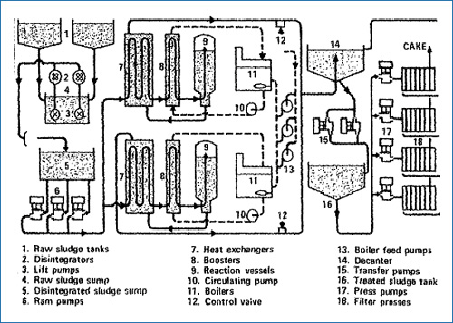High-Pressure Steam Pre-Treatment for Anaerobic Digestion of Municipal and Industrial Sludge:
Thermal Hydrolysis Sludge Pre-Treatment:
Thermal Hydrolysis Process (THP) is a proven and reliable technology that has been used around the world since 1995 in existing and “green field” projects to reduce both disposal quantities and the cost of building and operating digesters. THP is a high-pressure steam pre-treatment for anaerobic digestion of municipal and industrial sludge and bio-waste. Applying THP technology results in doubled digester loading, increased biogas production, and a pathogen-free and stabilized biosolids product with increased cake dewaterability. This saves both transport and energy costs, whether applying the end product directly in agriculture or drying it for fertilizer or bio-fuel. The THP is highly energy-efficient with low operating costs. It also eliminates odour problems associated with the treatment of organic materials. The end product (digestate) – a pathogen free and pasteurized biosolids can be applied to land directly, composted or dried. THP plants can be combined with cogeneration plants, which produce green electricity and provide hot steam for the Thermal Hydrolysis Process. However, the biogas can also be cleaned to be used as vehicle fuel or as a replacement of natural gas. scope of delivery varies from the core THP to complete turnkey digestion plants. We also offer plant operations & maintenance. The THP plants normally handles sludge from wastewater treatment plants for populations upwards from 150,000, or from approximately 5,000 dry metric tons/year of sludge. THP enhanced sludge treatment maximizes both flexibility and profitability.
What is Thermal Hydrolysis, and What Does It Do?
– Disintegrates cell structure and organic materials and dissolves naturally occurring cell polymers (exopolymeric substances – EPS), a form of protein, into an easily digestible feed for anaerobic digestion. – The resulting less viscous (more fluid) sludge allows doubling of digester dry solids (DS) loading with stable operations. – Increases sludge and bio-waste biodegradability and therefore yields more biogas. – Better dewatering – up to 40% total dry solids – by releasing water bound in EPS (EPS binds 4 – 5 g water / g EPS). This gives less biosolids after digestion and dewatering. – Produces an efficient and pathogen-free fertilizer: Treating the material at 165°C for 20 minutes meets all known standards and requirements for sterilization, including the EU Animal By Products Regulation (ABPR, 1774/2002/EC) category II & III materials.
Why Thermal Hydrolysis?
Enhanced biogas production:
– 50-65% of the organic matter (Volatile Solids – VS) in sludge converted to biogas – High quality biogas, rich in methane, low in H2S – Ideal for green electricity, as renewable vehicle fuel, or substitute for natural gas
Improved dewaterability after digestion by 50% – 100%:
– Dewatering up to 40% DS (dry solids). – Less material handling/transport. – Significant mass reduction. – Less water evaporation for sludge drying. – Digested and dewatered cake stockpiles and composts easily without any additional structural material.
Pasteurization and stabilization of final biosolids product /cake:
– Thermal treatment at 165°C for 20-30 minutes before digestion eliminates all pathogens – No regrowth or reactivation of bacteria. – Increased stabilization of cake after digestion due to high organic matter conversion.
The digested sludge has no negative odour:
– Odour nuisances prevented due to the closed process cycle.
Highly energy-efficient and reliable process:
– Maximum reuse of steam in thermally insulated vessels – Maximum dry-solids feed (16-17% DS) to the Thermal Hydrolysis Process – Thermal energy use is thus comparable or even less than other methods of pasteurization – Direct steam injection avoids clogging and unexpected shut downs of heat exchangers
Lower retention time and higher dry-solids content in digesters:
– Reduced viscosity from thermal hydrolysis (making the sludge more fluid). – Digesters can be fed with a sludge concentration of 8-12% dry solids (DS), twice that of a conventional digester. – Increased speed of digestion. – Together these factors increase digester capacity 2-3 times, with loading rates up to 6kg/m3/day of organic matter.
Robust anaerobic digestion process:
– Ideal feed for anaerobic digestion; consistent and free of unwanted micro-organisms. – Elimination of foam-causing filamentous bacteria – High alkaline buffering capacity – High active biomass concentration
Compact design makes THP easy to retrofit to existing sludge treatment plants Existing digester assets can be used to treat sludge or other bio-wastes from a wider region without further investment:
– Existing digester systems can be fed at more than double conventional rates, thus increasing the capacity of existing plants or minimising capital expenditure for new digesters.
